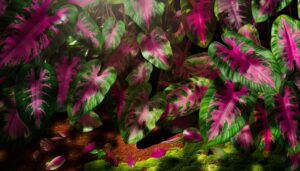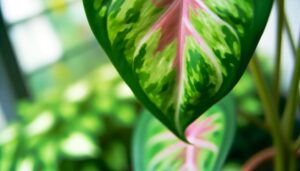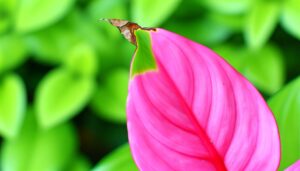What Is a Philodendron Selloum Sun Red?
Philodendron Selloum Sun Red, scientifically identified as *Thaumatophyllum bipinnatifidum*, originates from South America, particularly Brazil. This ornamental plant, from the Araceae family, is noted for its large, pinnatifid leaves that undergo a fascinating chromatic shift from red to green due to anthocyanin pigments.
Ideal growth occurs in indirect, bright light at temperatures of 18-27°C, with humidity levels of 60-80%. The plant thrives in a well-draining substrate composed of peat, perlite, and orchid bark.
Propagation is typically achieved using stem cuttings. Discover more about maximizing its aesthetic and botanical potential.

Key Takeaways
- Philodendron Selloum Sun Red is a plant from the Araceae family, originating from South America, especially Brazil.
- It features deeply divided leaves that transform from red to green, demonstrating heteroblastic growth.
- The plant thrives in indirect, bright light and requires high humidity levels of 60-80%.
- Ideal growing conditions include temperatures between 18-27°C (64-81°F) and well-draining soil mixes.
- Propagation is primarily through stem cuttings, maintaining high humidity and stable temperatures for successful rooting.
Origin and History
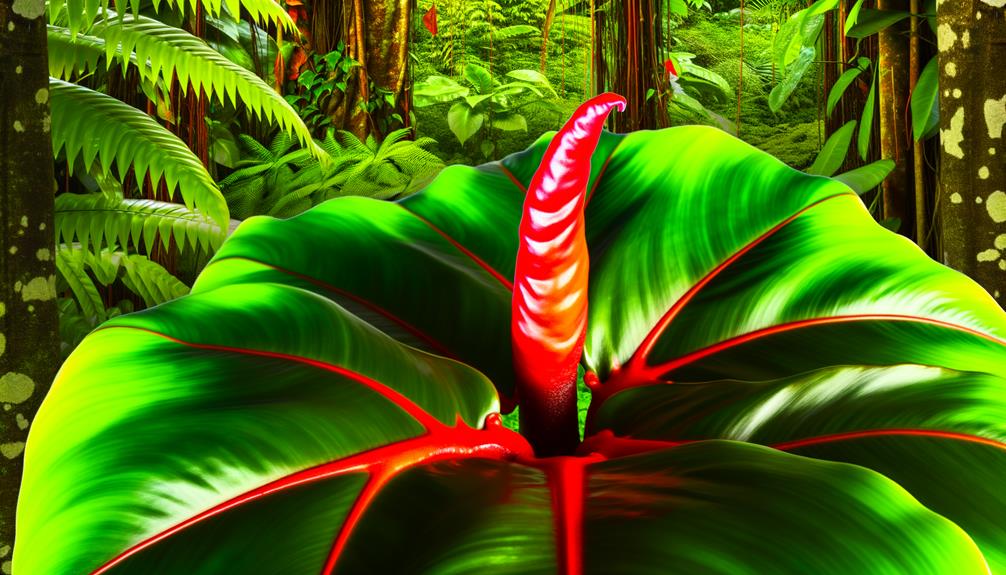
Originating from the tropical regions of South America, particularly Brazil, Philodendron Selloum Sun Red (Philodendron bipinnatifidum) is a cultivar renowned for its distinctive foliage and vibrant coloration.
Historically, the genus Philodendron, a member of the Araceae family, was first described by Heinrich Wilhelm Schott in the 19th century. P. bipinnatifidum is one of the most studied species within this genus due to its unique adaptive features and ornamental appeal.
Initially confined to humid rainforests, the plant has been extensively cultivated worldwide for both indoor and outdoor use. Its historical significance in horticulture is underscored by its contribution to plant collection periods during the Victorian era, where it was sought after for its exotic aesthetic and resilience in varied climates.
Unique Features
The Philodendron Selloum Sun Red is distinguished by its deeply divided, pinnatifid leaves that display a striking change from vibrant red in new growth to a mature, glossy green. This species, part of the Araceae family, demonstrates heteroblastic growth, where young and mature forms differ significantly. Its petioles are sturdy and uphold the sizable leaf blades, contributing to an impressive overall structure. The color shift is a notable phenotypic trait, influenced by anthocyanin pigments in young leaves.
| Feature | Description |
|---|---|
| Leaf Morphology | Deeply divided, pinnatifid |
| Color Transformation | Red (new growth) to glossy green (mature) |
| Family | Araceae |
| Growth Pattern | Heteroblastic |
| Pigmentation | Anthocyanin in new leaves |
These distinct characteristics make it a highly desired specimen for plant enthusiasts.
Ideal Growing Conditions
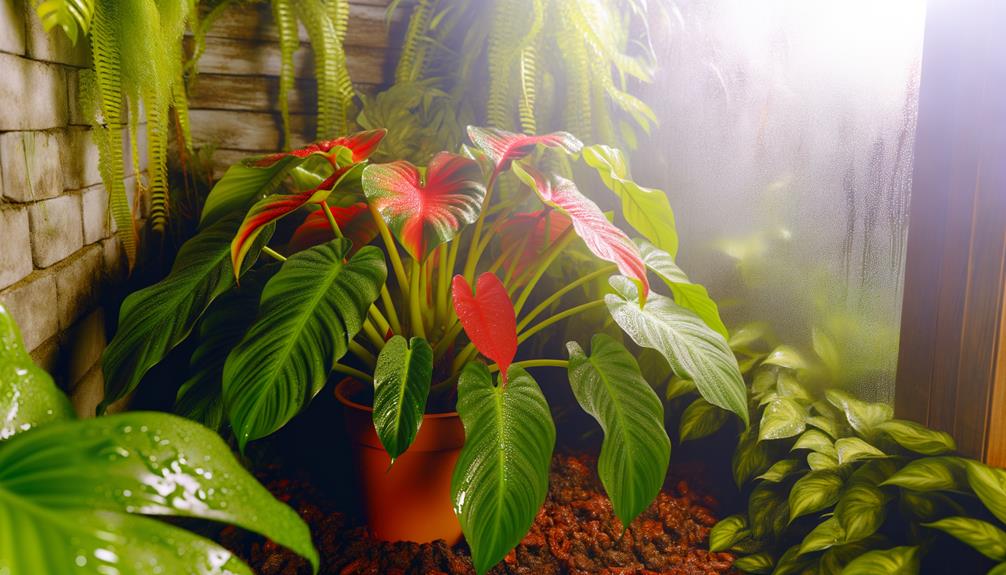
Philodendron Selloum Sun Red thrives in environments with indirect, bright light, where it can receive filtered sunlight akin to its native understory habitats.
Best growth is achieved at temperatures between 18°C and 27°C (64°F to 81°F), ensuring the avoidance of temperature extremes that could stress the plant.
Humidity levels should be maintained at 60-80%, reflecting the moist conditions of tropical rainforests.
The substrate should be well-draining yet capable of retaining sufficient moisture, ideally a mix of peat, perlite, and orchid bark to foster aeration and prevent root rot.
Regularly monitoring for pests and diseases is vital, as healthy foliage is essential for photosynthesis and overall health.
These conditions collectively support the plant's physiological processes, promoting robust growth and vibrant foliage.
Watering Requirements
Understanding the watering requirements of Philodendron Selloum Sun Red is important to maintaining the ideal humidity levels and preventing both dehydration and waterlogging. This tropical species thrives in consistently moist but well-drained soil. Overwatering can lead to root rot, while insufficient watering may cause leaf browning and wilting.
It is advisable to water when the top inch of soil feels dry to the touch. Employing distilled or rainwater can prevent mineral buildup, ensuring best plant health. Monitoring relative humidity levels, ideally between 60-80%, is essential to replicate its native environment. Utilizing a hygrometer can aid in maintaining these conditions.
Seasonal adjustments are also necessary; reduce watering frequency during the plant's dormant period in winter to avoid over-saturation.
Soil and Fertilization
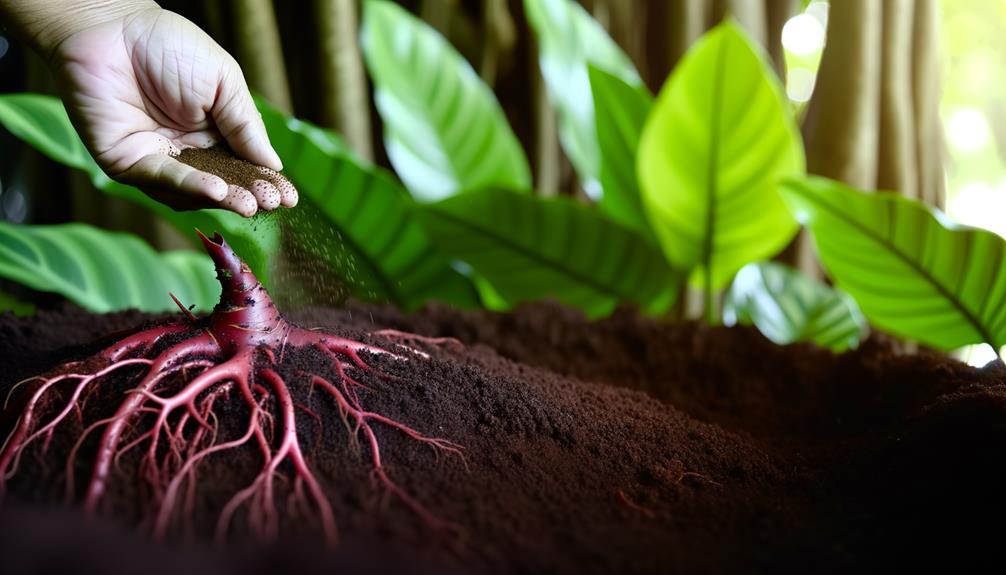
Philodendron Selloum Sun Red flourishes most in a well-draining, loamy soil blend. Ideally, the soil mix should consist of peat, perlite, and pine bark to ensure ideal aeration and moisture retention.
For fertilization, it is recommended to use a balanced, slow-release fertilizer with an N-P-K ratio of 10-10-10. This fertilizer should be applied every other month during the growing season to encourage strong growth and colorful foliage.
It is crucial to monitor the soil's pH level to keep it between 5.5 and 6.5. Maintaining the appropriate pH range is essential to avoid nutrient deficiencies and to ensure the plant's peak nutrient uptake.
Ideal Soil Composition
A well-draining, nutrient-rich substrate is essential for the best growth of Philodendron Selloum Sun Red. This substrate is often composed of equal parts peat moss, perlite, and pine bark. Peat moss (Sphagnum spp.) provides organic matter and retains moisture, essential for root development.
Perlite, a form of volcanic glass, enhances aeration and prevents soil compaction, facilitating oxygen availability to the roots. Pine bark (Pinus spp.) adds structural stability while allowing excess water to drain, preventing root rot. This combination creates an ideal environment that mimics the plant's native tropical habitat.
Additionally, maintaining a slightly acidic to neutral pH range of 5.5 to 7.0 is recommended. This pH range ensures nutrient availability and uptake efficiency for Philodendron Selloum Sun Red.
Fertilizer Application Tips
To optimize the growth and vibrancy of Philodendron Selloum Sun Red, it is vital to implement a well-balanced fertilization strategy, incorporating both macronutrients and micronutrients tailored to its specific needs.
Utilize a balanced fertilizer with an N-P-K ratio of 20-20-20, applied bi-monthly during the active growing season. Macronutrients such as nitrogen (N), phosphorus (P), and potassium (K) are pivotal for foliage development, root growth, and overall plant health.
Equally significant are micronutrients like iron (Fe), magnesium (Mg), and manganese (Mn), which support chlorophyll production and enzyme functions. Maintain the soil pH between 5.5 and 7.0 to facilitate nutrient absorption.
Avoid over-fertilization, which can result in nutrient imbalances and root damage.
Light Preferences
Exhibiting a preference for bright, indirect light, Philodendron Selloum Sun Red thrives best when shielded from direct sunlight to prevent leaf scorching. This tropical plant, known scientifically as Philodendron bipinnatifidum, requires a carefully balanced light environment to maintain its vibrant foliage and overall health.
Exposure to harsh, direct light can cause chlorophyll degradation, leading to brown, crispy edges on the leaves. Best illumination conditions include:
- Filtered sunlight through sheer curtains which mimics the dappled light of its native understory habitat.
- Placement near east or north-facing windows to ensure ample light without the risk of excessive heat.
- Supplemental artificial lighting during shorter winter days, ensuring consistent light exposure.
Proper light management is essential for the photomorphogenesis and photosynthetic activity of this ornamental species.
Common Pests and Diseases
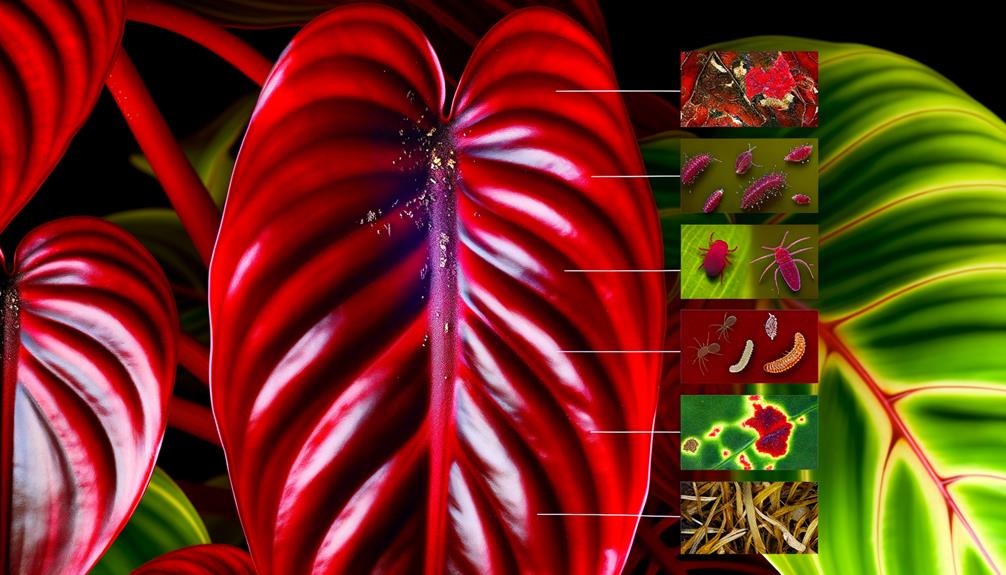
Philodendron Selloum Sun Red is susceptible to a range of pests and diseases, with common issues including infestations by *Spider mites* (Tetranychus urticae) and *Scale insects* (Coccoidea), as well as fungal infections such as *Leaf spot* (caused by various fungi including *Cercospora* spp. and *Phyllosticta* spp.).
*Spider mites* are microscopic arachnids that cause stippling and discoloration on leaves, while *Scale insects* appear as small, immobile bumps, excreting honeydew that fosters sooty mold. *Leaf spot* manifests as necrotic lesions, leading to chlorosis and defoliation.
Effective management includes regular inspection, maintaining ideal humidity, and employing insecticidal soaps or fungicides. Integrated Pest Management (IPM) strategies are recommended to sustainably control these phytopathological challenges.
Propagation Tips
Fostering a healthy Philodendron Selloum Sun Red not only involves managing pests and diseases but also understanding effective propagation techniques to cultivate robust specimens.
Propagation primarily occurs through stem cuttings, ensuring the genetic uniformity of Philodendron bipinnatifidum. Select a mature, disease-free stem segment and use sterilized pruning shears to make a clean cut.
For best results:
- Rooting Medium: Utilize a well-draining mix of perlite and peat moss to promote root development.
- Humidity: Maintain high humidity levels by covering the cutting with a plastic bag.
- Temperature: Maintain a stable environment with temperatures between 24-27°C (75-80°F).
This careful approach enhances the likelihood of successful propagation, yielding healthy, vibrant Philodendron Selloum Sun Red plants.
Conclusion
In summation, Philodendron selloum 'Sun Red' represents a botanical marvel, originating from the tropical regions of South America. Its distinctive foliage, ideal growth in well-draining soil, and preference for moderate hydration underscore its horticultural value.
Requiring bright, indirect light and vigilance against common pests, it flourishes under careful care. Propagation through stem cuttings guarantees its perpetuation. This remarkable specimen epitomizes the convergence of aesthetic appeal and botanical resilience, meriting its esteemed status among enthusiasts.


